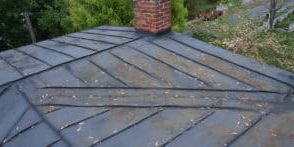
Terne Metal Roofs
More Information
Wikipedia![]()
Roofing for Historic Buildings![]() , National Park Service, Preservation Briefs
, National Park Service, Preservation Briefs![]() . 4 Roofing.
. 4 Roofing.
In the 1860's, the options for metal roofs were copper, lead, tin-coated iron, and terne-coated steel. Tin-coated malleable iron was disappearing at the time. Copper and terne rolled roofs were very popular during that vintage--terne more so because it was less expensive.
Terne is an alloy of lead and tin that provides excellent corrosion protection for steel. It was recently taken off the market due to the politics of lead, although no specific health threat was ever established. Terne roofs can last a very long time. A lot of terne roofs are a good 100 years old. To say a terne roof would last 170 years might be optimistic, but it's not out of the question if the roof has been well maintained over the years--especially if it's located in a benign climate like that in some of the drier western states.
History of Metal Roofs in America
From John Leeke's Historic HomeWorks
Last Tin Roof
All over the historic areas of Northern Virginia roofs of houses, state buildings and even barns have been protected by what we’ve come to know as the tin roof.
In 2012, Follansbee Steel (History video) stopped producing what we have come to know as terne metal or tin roofing; the company was founded in the early 1800’s and had changed hands a number of times since then. Terne is a mild steel with a coating of zinc and tin alloy to protect the steel from rust. Once the material is formed and installed it gets painted; as long as the paint is kept up once every ten-fifteen years you are left with a roof that can last a century.
Lyons Contracting
Metal roofing in America is principally a 19th-century phenomenon. Before then the only metals commonly used were lead and copper. For example, a lead roof covered "Rosewell," one of the grandest mansions in 18th century Virginia. But more often, lead was used for protective flashing. Lead, as well as copper, covered roof surfaces where wood, tile, or slate shingles were inappropriate because of the roof's pitch or shape.
Copper with standing seams covered some of the more notable early American roofs including that of Christ Church (17271744) in Philadelphia. Flat-seamed copper was used on many domes and cupolas. The copper sheets were imported from England until the end of the 18th century when facilities for rolling sheet metal were developed in America.
Sheet iron was first known to have been manufactured here by the Revolutionary War financier, Robert Morris, who had a rolling mill near Trenton, New Jersey. At his mill Morris produced the roof of his own Philadelphia mansion, which he started in 1794. The architect Benjamin H. Latrobe used sheet iron to replace the roof on Princeton's "Nassau Hall," which had been gutted by fire in 1802.
The method for corrugating iron was originally patented in England in 1829. Corrugating stiffened the sheets, and allowed greater span over a lighter framework, as well as reduced installation time and labor. In 1834 the American architect William Strickland proposed corrugated iron to cover his design for the market place in Philadelphia.
Galvanizing with zinc to protect the base metal from rust was developed in France in 1837. By the 1850s the material was used on post offices and customhouses, as well as on train sheds and factories. In 1857 one of the first metal roofs in the South was installed on the U.S. Mint in New Orleans. The Mint was thereby " fireproofed" with a 20gauge galvanized, corrugated iron roof on iron trusses.
Tinplate iron, commonly called "tin roofing," was used extensively in Canada in the 18th century, but it was not as common in the United States until later. Thomas Jefferson was an early advocate of tin roofing, and he installed a standingseam tin roof on "Monticello" (ca. 17701802). The Arch Street Meetinghouse (1804) in Philadelphia had tin shingles laid in a herringbone pattern on a "piazza" roof.
However, once rolling mills were established in this country, the low cost, light weight, and low maintenance of tin plate made it the most common roofing material. Embossed tin shingles, whose surfaces created interesting patterns, were popular throughout the country in the late 19th century. Tin roofs were kept wellpainted, usually red; or, as the architect A. J. Davis suggested, in a color to imitate the green patina of copper.
Terne plate differed from tin plate in that the iron was dipped in an alloy of lead and tin, giving it a duller finish. Historic, as well as modern, documentation often confuses the two, so much that it is difficult to determine how often actual "terne" was used.
Zinc came into use in the 1820s, at the same time tin plate was becoming popular. Although a less expensive substitute for lead, its advantages were controversial, and it was never widely used in this country.
|
Help support this site
|